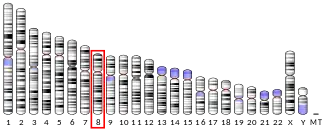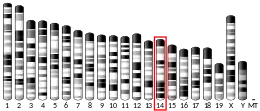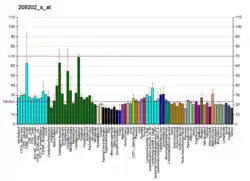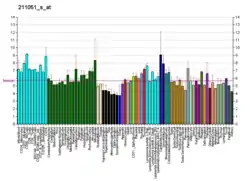| EXTL3 | |||||||||||||||||||||||||||||||||||||||||||||||||||
|---|---|---|---|---|---|---|---|---|---|---|---|---|---|---|---|---|---|---|---|---|---|---|---|---|---|---|---|---|---|---|---|---|---|---|---|---|---|---|---|---|---|---|---|---|---|---|---|---|---|---|---|
| Identifiers | |||||||||||||||||||||||||||||||||||||||||||||||||||
| Aliases | EXTL3, BOTV, EXTL1L, EXTR1, REGR, RPR, exostosin like glycosyltransferase 3, ISDNA | ||||||||||||||||||||||||||||||||||||||||||||||||||
| External IDs | OMIM: 605744 MGI: 1860765 HomoloGene: 1103 GeneCards: EXTL3 | ||||||||||||||||||||||||||||||||||||||||||||||||||
| |||||||||||||||||||||||||||||||||||||||||||||||||||
| |||||||||||||||||||||||||||||||||||||||||||||||||||
| |||||||||||||||||||||||||||||||||||||||||||||||||||
| |||||||||||||||||||||||||||||||||||||||||||||||||||
| |||||||||||||||||||||||||||||||||||||||||||||||||||
| Wikidata | |||||||||||||||||||||||||||||||||||||||||||||||||||
| |||||||||||||||||||||||||||||||||||||||||||||||||||
Exostosin-like 3 is a protein that in humans is encoded by the EXTL3 gene.[5][6][7][8]
References
- 1 2 3 GRCh38: Ensembl release 89: ENSG00000012232 - Ensembl, May 2017
- 1 2 3 GRCm38: Ensembl release 89: ENSMUSG00000021978 - Ensembl, May 2017
- ↑ "Human PubMed Reference:". National Center for Biotechnology Information, U.S. National Library of Medicine.
- ↑ "Mouse PubMed Reference:". National Center for Biotechnology Information, U.S. National Library of Medicine.
- ↑ Van Hul W, Wuyts W, Hendrickx J, Speleman F, Wauters J, De Boulle K, Van Roy N, Bossuyt P, Willems PJ (Apr 1998). "Identification of a third EXT-like gene (EXTL3) belonging to the EXT gene family". Genomics. 47 (2): 230–7. doi:10.1006/geno.1997.5101. PMID 9479495.
- ↑ Wuyts W, Van Hul W, Hendrickx J, Speleman F, Wauters J, De Boulle K, Van Roy N, Van Agtmael T, Bossuyt P, Willems PJ (Mar 1998). "Identification and characterization of a novel member of the EXT gene family, EXTL2". Eur J Hum Genet. 5 (6): 382–9. doi:10.1159/000484796. PMID 9450183.
- ↑ Mizuno K, Irie S, Sato TA (Mar 2001). "Overexpression of EXTL3/EXTR1 enhances NF-kappaB activity induced by TNF-alpha". Cell Signal. 13 (2): 125–30. doi:10.1016/S0898-6568(00)00144-3. PMID 11257457.
- ↑ "Entrez Gene: EXTL3 exostoses (multiple)-like 3".
Further reading
- Saito T, Seki N, Yamauchi M, et al. (1998). "Structure, chromosomal location, and expression profile of EXTR1 and EXTR2, new members of the multiple exostoses gene family". Biochem. Biophys. Res. Commun. 243 (1): 61–6. doi:10.1006/bbrc.1997.8062. PMID 9473480.
- Nagase T, Ishikawa K, Miyajima N, et al. (1998). "Prediction of the coding sequences of unidentified human genes. IX. The complete sequences of 100 new cDNA clones from brain which can code for large proteins in vitro". DNA Res. 5 (1): 31–9. doi:10.1093/dnares/5.1.31. PMID 9628581.
- McCormick C, Duncan G, Goutsos KT, Tufaro F (2000). "The putative tumor suppressors EXT1 and EXT2 form a stable complex that accumulates in the Golgi apparatus and catalyzes the synthesis of heparan sulfate". Proc. Natl. Acad. Sci. U.S.A. 97 (2): 668–73. Bibcode:2000PNAS...97..668M. doi:10.1073/pnas.97.2.668. PMC 15388. PMID 10639137.
- Kobayashi S, Akiyama T, Nata K, et al. (2000). "Identification of a receptor for reg (regenerating gene) protein, a pancreatic beta-cell regeneration factor". J. Biol. Chem. 275 (15): 10723–6. doi:10.1074/jbc.275.15.10723. PMID 10753861.
- Kim BT, Kitagawa H, Tamura Ji J, et al. (2002). "Demonstration of a novel gene DEXT3 of Drosophila melanogaster as the essential N-acetylglucosamine transferase in the heparan sulfate biosynthesis: chain initiation and elongation". J. Biol. Chem. 277 (16): 13659–65. doi:10.1074/jbc.M111630200. PMID 11832488.
- Strausberg RL, Feingold EA, Grouse LH, et al. (2003). "Generation and initial analysis of more than 15,000 full-length human and mouse cDNA sequences". Proc. Natl. Acad. Sci. U.S.A. 99 (26): 16899–903. Bibcode:2002PNAS...9916899M. doi:10.1073/pnas.242603899. PMC 139241. PMID 12477932.
- Gerhard DS, Wagner L, Feingold EA, et al. (2004). "The Status, Quality, and Expansion of the NIH Full-Length cDNA Project: The Mammalian Gene Collection (MGC)". Genome Res. 14 (10B): 2121–7. doi:10.1101/gr.2596504. PMC 528928. PMID 15489334.
- Bishnupuri KS, Luo Q, Korzenik JR, et al. (2007). "Dysregulation of Reg gene expression occurs early in gastrointestinal tumorigenesis and regulates anti-apoptotic genes". Cancer Biol. Ther. 5 (12): 1714–20. doi:10.4161/cbt.5.12.3469. PMID 17106246.
This article is issued from Wikipedia. The text is licensed under Creative Commons - Attribution - Sharealike. Additional terms may apply for the media files.





